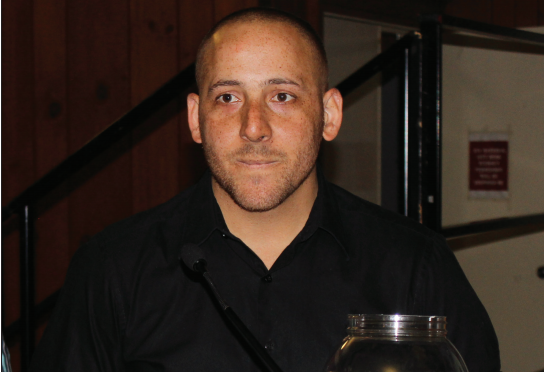

Photo Credit / Jamie Reese
By Samantha Sheridan
SC Staff Writer
Kevin Hines, the award-winning author of the book “Cracked, Not Broken: Surviving and Thriving After a Suicide Attempt,” spoke in the Keystone Room at East Stroudsburg University on September 30 as a part of Suicide Prevention Month.
Hines told the story of his struggles with bipolar disorder type 1 with psychotic features, which ultimately led him to an attempted suicide by jumping off the Golden Gate Bridge.
He suffers from auditory and visual hallucinations, along with mania and paranoia. Bipolar disorder runs in his family, and both of his biological parents suffered from it.
To give some perspective, at one time Hines was convinced the United States Post Office was trying to kill him.
He is one of 34 known to have survived the jump off the Golden Gate Bridge. His suicide attempt occurred on September 25, 2000 at 19 years old. It took him approximately four seconds to fall the 220 feet to the water.
Because of the fall, parts of his legs and vertebrae were shattered. He was ultimately saved by an onlooker who called the coast guard upon his jump, and an alleged sea lion that hovered under him, helping to keep him afloat until the coast guard arrived.
His injuries required a surgery that was brand new at the time, along with a long recovery. For a time he was unable to walk, and he had to spend time in the psychiatric ward.
In the moments before his jump, Hines experienced elation, but he regretted the decision to kill himself as soon as he acted upon it.
Hines stated that his biggest mistake in his journey was choosing to stay silent. He tells his story to bring attention to an issue that often goes unnoticed by many.
Hines said, “If just one person would have come up to me and asked me ‘Are you ok? Is something wrong?’ I would have told them everything. The question is: would they have listened?”
He continued, “It’s all of our responsibility to see pain.”
He hopes to help change the stigma that surrounds mental illness and suicide. He also hopes to bring awareness to others so they will reach out to those showing signs of suicidal thoughts.
His message is simple: “The lack of empathy [regarding mental illness and suicide] is massive around the world, and we have to change that.”
Hines continues to fight his mental illness and has a strict routine. He wakes up and goes to sleep at the same times each day, eats around the same times, goes to therapy, takes medication, uses Blue Wave Light Box technology, and exercises regularly.
Although he is making incredible strides regarding his own mental health, Hines has been admitted into the psychiatric ward 11 times since his suicide attempt.
“Resiliency is why I’m alive. Be resilient for yourself,” said Hines. “I will never attempt to take my life again. I know who I am. Each and every one of you has a gift, and it’s called life.”
Email Samantha at:
sks5945@live.esu.edu
